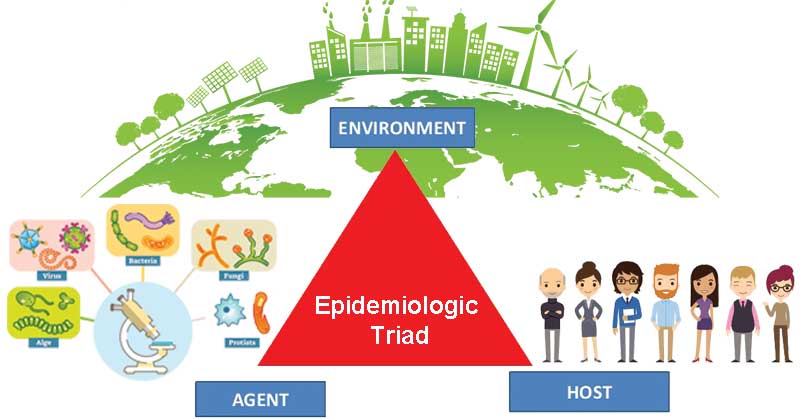Q: Shouldn’t everyone be equally vulnerable?
A: A virus just wants to reproduce itself, and so in this sense it does not discriminate, seeking out any host it can find from your next-door neighbor to the Prime Minister of the UK. But to understand that while no one is completely safe, some people face much greater risk than others, we turn to a staple of infectious disease epidemiology, the Epidemiological Triad (see photo).
The triad consists of an agent, a susceptible host, and an environment. The “agent” is the infectious pathogen, the “host” is the person who can get the disease, and the “environment” is the external factors that can influence the host and the opportunity to get infected.
This simple model provides a good lens into why any infectious agent does not ultimately infect at random. Many characteristics of the “host” can impact the likelihood of exposure, susceptibility once exposed, and ultimate disease course once infected. We’ve talked about how social factors such as occupation and the ability to work from home or avoid public transportation all directly affect your likelihood of exposure to COVID-19. Household crowding and living in a multi-generational household are other factors that likely increase risk of exposure. Likewise, one’s immune function and ability to fight off an infection has a lot to do with your age, overall health status, as well as chronic “stressors” caused by socioeconomic disadvantage and racial discrimination.
Nerdy Girls Amanda and Jenn have collaborated for many years showing these links between social factors, stress, and immune function (some links for those interested below). Professor Sheldon Cohen also conducted some super cool experiments where he randomly assigned people to be exposed to a cold viruses (rhinovirus and a type of coronavirus) via a nasal sprays. People with higher levels of reported stress as well as lower subjective social status were more likely to become infected with clinical colds (link to studies below).
The “environment” refers to external factors that affect the agent and the opportunity for exposure. This can include environmental factors such as geography and climate, biological factors such as insects that transmit the agent (not so relevant for COVID), and socioeconomic factors such as crowding, sanitation, and the availability of health services. For COVID-19 the jury is still out on climate/temperature, but we have a good evidence that crowded indoor spaces are hazardous, including certain occupational settings such as meat-packing plants and front-line health care work.
The important takeaway is that is the interaction of infection-host-environment that determines the patterning of infection and disease. This is why infectious disease epidemiology quickly becomes social epidemiology, which has been particularly salient to us all this week. Stay well, and take care of each other!
Sheldon Cohen Cold experiments:
Jenn and Amanda research on social factors and infection/immunity:



